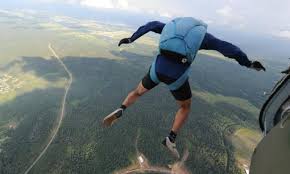“Capsule”
 The extremal made a preplanned jump without a parachute from a height of 7620 meters and landed on a network stretched over the California desert.
The extremal made a preplanned jump without a parachute from a height of 7620 meters and landed on a network stretched over the California desert.
“This is a tiny object for such a height,” Akins told the television interview. “You cannot make out the network; you see only the earth.” But as you get closer you can see the details on the ground. ”
Parachutists know the position of the “box” – when the athlete falls flat, with legs elongated at 45 degrees, while his arms and head are raised and form the letter “W”.
In this position, paratroopers are able to move horizontally in the air. They can use their hands like wings of an airplane, performing aerial maneuvers.
“All of this — for example, trying to fly in the direction of a softer landing pad — increases your chances of survival,” says Professor Bjornstig.
And, finally, the last thing a falling person can help himself is to change his position before hitting the ground.
“The most reasonable way is to land on your feet,” says Professor Bjornstig.
In the normal mode, parachutists are also recommended to land on full feet, and after touching the ground, to fall on their side. In addition, to weaken the force of the blow, instructors advise slightly bending the knees and keeping your legs tense. Of course, the debatable question is whether this will help at a speed of 200 km / h.
Skydiving is a highly adrenaline hobby. “There is no such thing as an absolutely safe parachute jump,” says the British Skydiving Association.
About one in 100 thousand jumps of professional parachutists ends in death.
Experience and quick wits will undoubtedly help to survive in the event of a parachute failure. But still the best assistant in this situation is luck.



